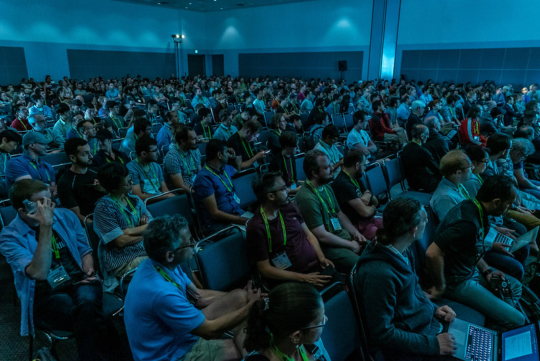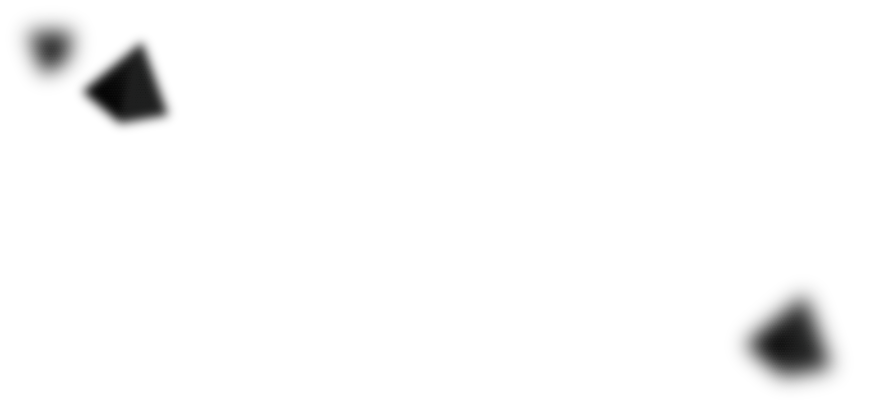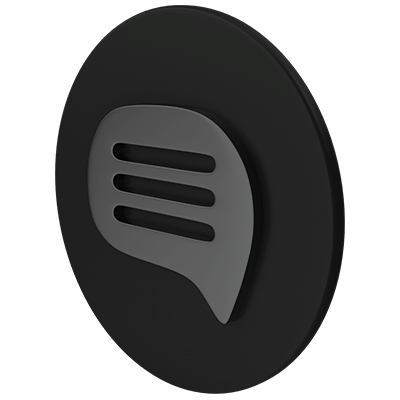Ideas From Experts
Talks
Explore emerging topics and adjacent content areas where ACM SIGGRAPH’s expertise in graphics, robotics, visualization, interaction, and simulation is uniquely suited to create solutions and further progress.




“Talks at SIGGRAPH has a little something for everyone, with content ranging from the latest in production techniques to breakthroughs in game development, and so much more. This year at SIGGRAPH, expect another great lineup of Talks, and I can’t wait to see these presentations at the conference!”
Chris Redmann
SIGGRAPH 2021 General Submissions Chair
How to Submit
SIGGRAPH 2021 will move forward at this time as a virtual-only event. We look forward to celebrating 48 years of advancements in computer graphics and interactive techniques in our virtual venue. We are excited you are submitting your work for consideration. As we finalize our conference plans, visit the About the Conference page for the latest updates.
Log into the submission portal, select “Make a New Submission” tab, and select “Talk.” To see the information you need to submit, view the Sample Submission Form. You will be asked for:
- A presentation format. To propose a talk, please select Talk as your presentation format. You will then be taken to the forms specific to this presentation format. Please see below for more information about required information and materials for this presentation format.
- One representative image suitable for use on the conference website and in promotional materials. See the Representative Image Guidelines tab located on the Submission FAQ page.
- A two-page abstract, in PDF format, describing your work. The abstract should include what area you work in, what is novel about your work, and how this work fits into existing work. See Publications Instructions for help with your abstract.
- Length of Talk: Short (20 minutes) or Long (40 minutes). Due to scheduling constraints, the jury will be significantly more demanding of submissions that request 40 minutes, so please be sure to justify why you need the extra time. If your talk can fit either format, we encourage you to request either length and let the jury decide which is more appropriate.
- A list of potential submission categories and keywords is provided to help ensure your submission is reviewed and juried appropriately. Please select the categories and keywords carefully.
Optional:
- Up to six supplementary images and/or a maximum three-minute supplementary video. We only accept uploaded videos in QuickTime, MPEG-4, or DivX Version 6 formats, and the file size should not exceed 200 MB. The file must be uploaded using the online submission system.
- Supplementary text document (PDF). This material can include text and images to help the jury further understand any unique results of your submission beyond the merits of your required abstract. This material is only for optional jury use and might not be reviewed. Critical information for your submission should be noted in your abstract. There are no limits to the length of supplementary text, but please remember that this material is for optional jury use, and reviewers may be overwhelmed by large volumes of supplementary information. Please try to limit the supplementary material to four pages if possible.
- Non-native English speakers are highly encouraged to use the English Review Services to help improve the text of submissions. Please note that this process takes time, so plan far ahead in order to meet the submission deadline.
- Educator’s Resources Submission. Those submitting content to a SIGGRAPH conference can indicate interest in donating materials of value to the education community on the ACM SIGGRAPH Education Committee website. Learn more.
- For additional submission information, please see Submissions FAQ.
Evaluation
Common Evaluation Criteria
Jurors are asked to evaluate your submission using four criteria: concept, novelty, interest, and quality. The final submission score is based on a combination of these factors. For example, a high-quality talk that has broad appeal and is unlike other recent SIGGRAPH Talks has a good chance of acceptance, while a poorly motivated submission of interest to few attendees (or that duplicates recent talks) probably will be rejected. Work is evaluated on the quality and completeness of the materials submitted.
Examples of accepted content from past conferences, including Talks, have been made freely available by the ACM SIGGRAPH organization and can be accessed here.
Concept
How exceptional are the ideas, problems, solutions, aesthetics, etc., presented in this submission? How coherently does the submission convey its overall concept? Is the concept similar to existing ones, or does it stand out? This criterion is particularly applicable to submissions that pull together existing technologies into a single product (for example, demos, animations, art pieces). Submissions of this type, where the individual technologies are not necessarily new but their combination is, are evaluated on both the final product and how well proposed technologies integrate to meet the desired goals. Many submissions in this area are rejected because they do what existing systems do, and they do not demonstrate that the proposed approach leads to better results.
Novelty
How new and fresh is this work? Is it a new, groundbreaking approach to an old problem, or is it an existing approach with a slightly new twist? You must first demonstrate to the jury that your work is sufficiently different from existing approaches. Second, you should evaluate your work in the context of other approaches where appropriate. Is it faster? Easier to use? Does it give better results? Is it more accurate? Many submissions are rejected either because the work is too similar to existing work or because the submission materials did not convince the jury that the improvements were substantial enough.
Interest
Will conference attendees want to see this? Will it inspire them? Are the results or approach appealing to a broad audience? This is partly a measure of how broad the potential audience is and partly a measure of the overall clarity and novelty of the submission. A submission in a very niche area is more likely to be accepted if the results are exceptionally better than what exists already or if the proposed solution might be applicable to other areas.
Quality, Craft, and Completeness
This is a measure of how well written the abstract is and the quality of the supporting materials. The abstract must effectively communicate both the problem and the solution in enough detail and clarity that the jury can evaluate it. You also must convince the jury that your solution works. Many submissions are rejected because, although the problem and solution seemed interesting, the materials did not convince the jury that the solution had actually been implemented and evaluated. If your submission has an animation, simulation, or interactive component, then including a video is essential.
Although submitters simply submit a talk, during the review process, the jury may sort Talks submissions into focus categories for some long-established communities within SIGGRAPH: research, production, and education. This sorting is used in scheduling accepted talks into meaningful sessions and to provide “at-a-glance” information to attendees. The primary reason for rejection of each type of talk is given below to help submitters understand what the jury will be looking for in typical Talks submissions.
Research Talks
Accepted Research Talks typically fall into one of two categories: an exploration of a new problem or a novel approach to an existing problem. For talks on new problems, the jury accepts those they believe will interest attendees and inspire subsequent discussions or research. For talks on solving existing problems, the jury accepts those that clearly solve a problem of interest to many attendees. Primary reasons a talk is rejected include:
- The jury was unconvinced the work solves a new or existing problem. This can happen either because the abstract did not clearly differentiate the work from existing work, or the proposed solution was too incremental.
- The jury was unconvinced that there was sufficient improvement over existing work. It is not sufficient for the approach to simply be new; the submission materials also must demonstrate that the proposed approach works better (it is faster, more accurate, uses less memory, easier to use, etc.) than existing work.
- The submission materials did not clearly convey both the problem and the proposed solution. If the jury has to struggle to understand the submission, they are unlikely to accept it. Good abstracts first provide a concise statement of the problem and solution, and then provide sufficient detail to convince the jury the submitter would present a compelling talk.
- The area is off topic and unlikely to be of interest to SIGGRAPH attendees.
- The jury believes the talk will be an extended advertisement for a product.
Production Talks
Accepted Production Talks typically explore solutions to problems frequently encountered in production environments. They should be motivated by unique visual results or the production pipeline rather than production scope, size, or budget. Examples include new applications of research ideas in a production setting, combining existing techniques in new and unique ways, or improvements to pipeline tools or workflow for improved efficiency. The jury accepts Production Talks that will interest attendees seeking details on production difficulties and their solutions, or because the technical details may interest the broader SIGGRAPH community. Production Talks are not limited to film and visual effects but could cover other application and production environments such as game development, mobile graphics, applications of interactive techniques, immersive environments, and art and design installations.
The abstract needs to provide context for the work and aesthetic goals, underlying technical solution, and some kind of evaluation metrics. To support the submission’s claims, we strongly encourage the inclusion of some kind of visual or video material, either work in progress or the finished result. The jury frequently rejects unsubstantiated submissions. It is possible to submit material for viewing only at the jury meeting (when it has not been approved for public display or release). Please contact the Talks Chair to make arrangements.
Primary reasons that a Production Talk is rejected:
- The jury was unconvinced the submission provides a substantially new solution to a production problem. Exceptions may be made when the solution is only known to a small community; in this case, clearly acknowledge previous work and explain how this talk reaches a broader audience.
- Workflow improvements are not supported by an objective measure (for example, a reduction in render time or short turnaround).
- Critical visual media are missing, making it difficult for the jury to judge the approach in practice. If media will be viewable only at the jury meeting, make that clear in the submission so jurors understand the images are only stand-ins.
- The talk fails to cite existing work or explain differences from existing approaches. Although Talks need not be as rigorous as research papers, a clear discussion of the historical context is important.
- For large productions with multiple Talks submissions, the jury may feel that there is some overlap, and some or all of the submitted talks could be merged into a single, stronger talk. In this case, they will reject one and accept the other, suggesting such a merger. If this is not acceptable, please contact the Talks Chair to discuss the situation.
- The jury is unclear what they would learn by attending the talk. Vague talks are a waste of attendee time. Your submission should provide insight on the talk content.
Education Talks
Accepted Education Talks can include case studies of exemplary interdisciplinary courses and projects, curricula, tools, and new courses at the leading edge of graphics and interactive techniques content. Most educators attending the conference focus on undergraduate education, but there also is interest in informal education, K-12 education, and graduate education. Education Talks are often scheduled as part of the Educator’s Forum at the conference. Submitters are asked to select education as a category when submitting to help identify works appropriate for this focus area.
Non-Disclosure Agreements
SIGGRAPH reviewers cannot sign non-disclosure agreements for submissions. For information on patents and confidentiality, see the Submissions FAQ.
Upon Acceptance
If your talk is accepted, you must prepare and submit a revised abstract (two pages maximum).
You will be notified of acceptance or rejection of your talk at the end of April 2021 and receive an email from “rightsreview@acm.org” with information about and a link to your work’s rights form within 72 hours of notification of acceptance of your work to the conference. When your rights form has been delivered to ACM, you will then receive an email from “tapsadmin@aptaracorp.awsapps.com” with information about the preparation and delivery of your material to TAPS for publication.
Please make sure that emails from “rightsreview@acm.org” and “tapsadmin@aptaracorp.awsapps.com” are part of the “allow list” in your email program, so that you do not miss these email messages.
The source (Word or LaTeX) of your abstract, as well as any supplemental materials, must be delivered to TAPS, ACM’s new article production system. TAPS will generate the PDF and HTML5 versions of your abstract for publication in the ACM Digital Library.
You must deliver your material to TAPS, resolve any formatting issues identified by TAPS or by the proceedings production editor, and approve your material for publication by 28 May 2021. If you cannot meet that deadline, you will not be allowed to present your material at SIGGRAPH 2021.
Information about the preparation and delivery of your final material to TAPS also can be found at https://homes.cs.washington.edu/~spencer/taps/taps.html.
After acceptance, the submission portal will allow you to update basic information about your work and upload any final materials for inclusion in the conference program and website. You will receive information on how to submit final versions of your accepted work and the deadlines for final updates.
If your talk is accepted, you must:
- Prepare and submit a revised, two-page abstract to TAPs by 28 May 2021 (required)
- Update your auxiliary images and video (optional)
- Prepare a 20- or 40-minute pre-recorded video (as determined by the jury)
- Present your work during SIGGRAPH 2021
Pre-Recorded Video Presentation
To present in the virtual conference, the Talks contributor must: 1) provide a pre-recorded video of their presentation and 2) plan for one Talks contributor to be present for the entirety of the virtual session for their talk. Final accepted video presentations will be published in the ACM Digital Library. Further details and instructions regarding the video specs will be provided upon acceptance.
Presenter Recognition
To present your work at SIGGRAPH 2021, at least one contributor per submission must register at the appropriate registration level. All other contributors can register at the level of their choice.
You can find a link to the contributor recognition policy here.
ACM Rights Management Form
If your work is accepted for presentation at SIGGRAPH 2021, you must complete the ACM Rights Management Form. The form will be sent to all submitters whose work is accepted.
Your representative image and text may be used for promotional purposes. Several SIGGRAPH 2021 programs — Art Gallery, Art Papers, Real-Time Live!, Technical Papers, and all installation programs — will prepare preview videos for pre-conference promotion of accepted content, which may include a portion of the video you submitted for review. You may grant or deny us the ability to use the representative image and submitted video for these purposes.
Timeline
23 February 2021, 22:00 UTC/GMT
Submission form deadline
End of April 2021
Acceptance or rejection notices are sent to all submitters.
10 May 2021
Deadline to make any changes to materials (i.e., approved title changes, presenter names, descriptions) for publication on the website.
28 May 2021
Two-page abstract due. If we do not receive your revised abstract by 28 May, you will not be allowed to present at SIGGRAPH 2021.
Summer 2021
SIGGRAPH 2021

